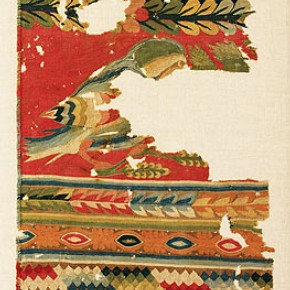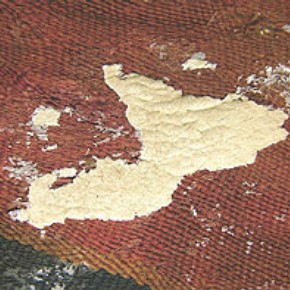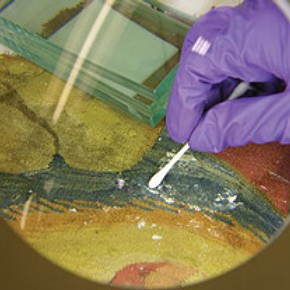Conservation Journal
Spring 2007 Issue 55
Treatment of two Coptic tapestry fragments
Recently the Victoria and Albert Museum lent nine Coptic textiles to the Yorkshire Museum, York for the exhibition Constantine The Great . The exhibition celebrated the life of the Christian convert and Roman Emperor who ended centuries of persecution of Christians by establishing religious tolerance within the Empire. The Coptic Christian Church was founded in Egypt in AD 451 and is closely associated with Constantine's reign. Among the loaned textiles were two tapestry fragments (Museum no 267-1889, 161.5 x 49.5cm Figure 1), (268-1889, 37 x 37cm) from Akhmim, Egypt. The two fragments, which on acquisition had been given one museum number, may be part of the same hanging. They are woven in linen and wool and are of similar design and colour palette. The designs consist of bands of vegetation and geometric patterns, birds are also represented and a water lily can be identified on the larger fragment.
The fragments had raw, fraying edges and many holes causing general weakness. In some areas the borders were detaching. The fibres were desiccated and brittle, there was discolouration from oxidation and ingrained soiling/dust, the colours however, had remained strong. There was also adhesive residue visible on the front surfaces. This had come through from the reverse of the pieces which had both apparently been adhered to cardboard with a white painted surface. Though most of the cardboard had been removed, there was a great deal of adhesive residue on the reverse and patches of white paint and cardboard remained (Figure 2). The white paint was analysed by Lucia Burgio, Senior Object Analysis Scientist, using EDXRF with a Rohntec ArtTAX spectrometer. The result showed titanium to be the predominant element indicating that the white paint was probably made from titanium oxide, a pigment commercially available from the 1920s. This suggests that the fragments had been adhered to the painted cardboard after their acquisition.
A positive iodine test and negative Biuret test confirmed the adhesive as a starch paste. It was proposed that the fragments be wet-cleaned to eliminate potential degradation products; including soiling and the cardboard residues, to relax the fibres, increase flexibility, realign the weave and to improve the colours. The dyes were tested in a solution of the non-ionic detergent Dehypon LS45® . All the colours were found to be stable in both water and detergent solution. The paint and cardboard residues were removed prior to wet-cleaning. As the residues were embedded in the starch paste it was not possible to remove them with damp cotton wool swabs. A sample of starch paste was placed in a droplet of water to test how long it took to swell, as this would make it easier to release the paint, but it took more than a day. This technique was therefore discounted, the risk of keeping a desiccated archaeological textile wet for this length of time was far too great.
The possibility of using an enzyme was investigated. Following research and discussion with Professor Hal Erickson, University of Texas, and colleagues at the V&A it was decided to test the Albertina Kompresse®. This ready-to-use poultice system contains a-amylase enzymes from the Bacillus species in a methylcellulose gel1. The system is not buffered, relying instead on the natural acidity of the textile to provide the conditions for the enzyme to work. The gel is supplied in a dry form, embedded in a polypropylene fleece material. This is cut to size and the enzymes reactivated with water by the user. As the textile was going to be wet-cleaned a slightly damper poultice than usual was used in order to penetrate the thick layer of starch. Tests proved successful, the total time the damp poultice needed to be in place to swell the starch was between 20-30 minutes. As the poultice swelled the starch, both it and the paint could easily be removed using a damp cotton wool swab (Figure 3). The process, which was carried out under magnification, took a total of 40 hours to treat the reverse of both fragments. The starch on the surface of the textile was successfully removed releasing the majority of the paint residues, but starch embedded in the fibres remained. An enzyme bath could have been employed to remove these residues. However, the quantity of enzyme required was very difficult to calculate and the additive (Ca+) was considered undesirable.
The fragments were wet-cleaned in a dilute solution of Dehypon LS45; including rinsing, the total duration of the bath was 45 minutes. It was hoped that the low levels of enzyme residue, left in the fragments from the poulticing treatment, would be released into the detergent bath, and that they in turn would remove the remaining starch. The wet-cleaning did succeed in extracting much of the remaining starch. It also reduced the soiling, relaxed the fibres, removed the creasing and brightened the colours.
Enzyme Seminar Day
The above treatment raised the whole issue of the use of enzymes in conservation treatments. Professor Hal Erickson, who was visiting the UK in March 2006, very kindly offered to come to the V&A and give a one day, intensive seminar on the subject. The following is a brief overview of the day.
Enzymes are proteins (polypeptides) which catalyse reactions. Their monomers are amino acids joined by peptide linkages (amide). The combination of amino acids dictates the folding or shape of the enzymes. This pre-ordained functional shape is what gives them their high degree of specificity and efficiency, often referred to as the 'lock and key' model.
The enzymes most commonly employed in conservation are the hydrolases which include proteases, lipases or glucidases (a-amylase). The source can be animal (pancreatic extracts), vegetable (cereal), microbial, bacterial or fungal. The latter two are the least expensive but, for conservation purposes, those from the purer, microbial source are preferable.
Enzymes cannot function without being able to move and, therefore, water or high humidity is essential for their activation. Enzymes also require very specific conditions to operate. These include ion balance, pH, temperature and concentration. Purified water, as used in textile conservation, can cause the enzymes to 'unfold', deactivating them. To counter this, ions (Ca2+ or Mg2+) need to be added, unless they are already extant in the object.
Enzymes are more soluble and therefore efficient at low concentrations. As it is usually almost impossible to quantify the amount of material to be removed, it is advisable to begin a treatment with a low enzyme concentration which can be increased if necessary.
Conservators are often concerned about enzyme residues remaining on objects. The conservation literature suggests that heat, 40ºC-50ºC, will denature enzymes. This is a misconception in most cases, as industrially manufactured enzymes are produced with robust disulfide bonds to protect them during storage and transportation. Other options such as an extreme adjustment of pH, the use of solvents and drying techniques are sometimes considered but these may well be harmful to the object. A more realistic approach is to inhibit the enzyme used by an incremental alteration to the pH or by introducing an enzyme-specific protein inhibitor. It should also be noted that water-soluble enzymes will generally readily flush away during washing.
At present there are no recorded negative effects from dry enzyme residues remaining on artefacts, other than the difficulty of reapplying starch paste in a treated area. In time enzymes will break down and oxidize, and there is a possibility this could cause slight browning. The use of enzymes is not risk free, the old adage 'like dissolves like' applies. Some enzymes act on peptide linkages. Ester linkages, which are very similar, may also be affected which may not be desirable. A small number of dyes may also undergo change, for example the glycoside ring of cochineal may be affected by a-amylase. The enzyme that carries the least risk, is most available and comes 'ready-to-use' is saliva. It is available in a purified, manufactured version but this tends to be expensive.
Enzymes are very specific and require exacting parameters for optimum results. Professor Erickson's final advice was to consider an enzyme treatment as a last resort. He also mentioned there has been some success amongst his students at swelling glues using propylene glycol for celluloses and urea for proteins, or a combination of both.
Acknowledgements
I am grateful to Professor Hal Erickson for his precious web assistance in the choice of treatment and for giving the seminar at the V&A, which was extremely useful and very much appreciated. I would also thank Lynda Hillyer, who entrusted me with the conservation of these fragments, and Elizabeth-Anne Haldane who shared her experience using the Albertina Kompresse® .Thanks are also due to Dr Lucia Burgio, to the textile conservation team and to Frances Hartog for assistance with this article.
Materials
Dehypon LS45®
http://conservationresources.com
Albertina Kompresse®
http://www.klug-conservation.com
References
1. Erickson, H.M., 'Usage Recommendations for a-Amylases : Maximizing enzyme activity while minimizing enzyme-artifact binding residues' The Book & Paper Group Annual 11, Washington DC, (AIC/BPG 1992) pp. 24-33.2. Haldane, E-A., McClean, L., 'Adapting Techniques: Cleaning A Covenanting Banner' Dust, Sweat and Tears: Recent Advances in Cleaning Techniques , Ed. Dawson, L., Berkouwer, M., (UKIC Textile Section 2003), pp.15-27.
Spring 2007 Issue 55
- Editorial Comment - Conservation Journal 55
- Stein Mellon Textile Project at the V&A
- Storage of the Stein Loan Collection
- Discoveries on a pair of cassoni
- Treatment of two Coptic tapestry fragments
- Surreal semi-synthetics
- Investigation of the patina on Bidri using advanced surface analysis techniques
- Printer friendly version


